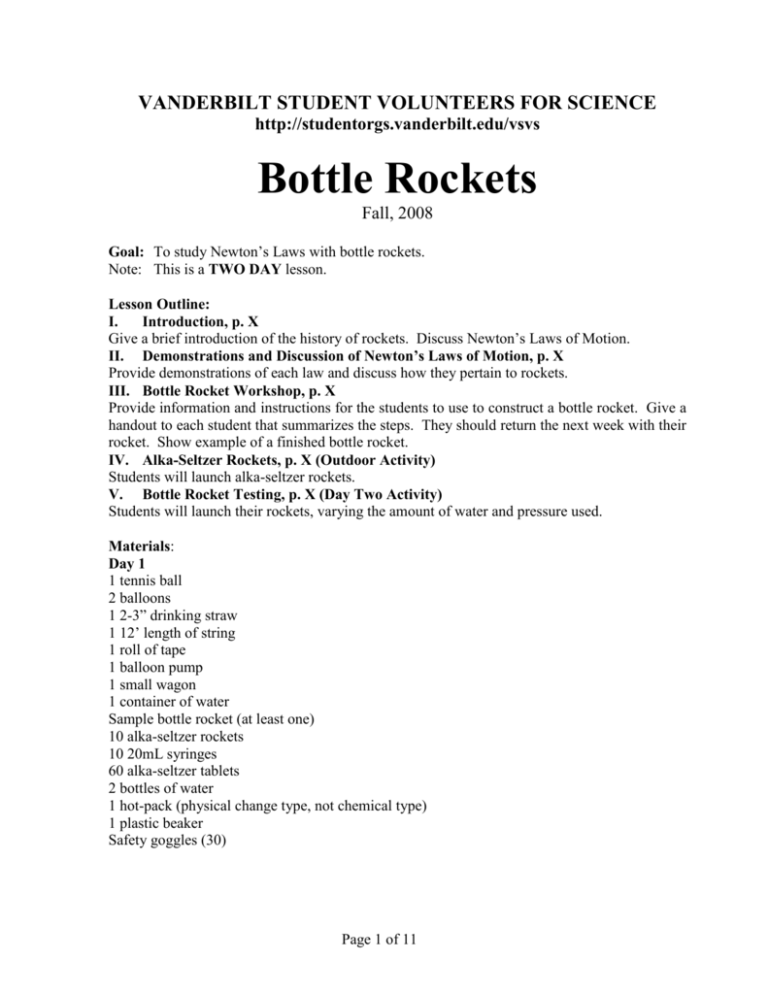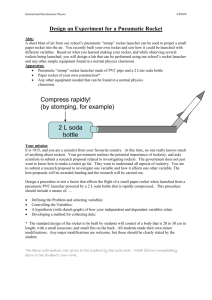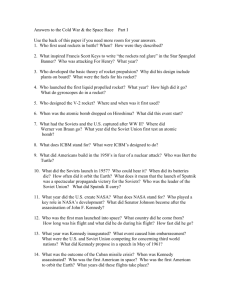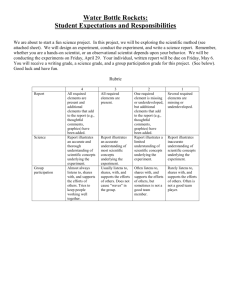Lesson - Vanderbilt University
advertisement

VANDERBILT STUDENT VOLUNTEERS FOR SCIENCE http://studentorgs.vanderbilt.edu/vsvs Bottle Rockets Fall, 2008 Goal: To study Newton’s Laws with bottle rockets. Note: This is a TWO DAY lesson. Lesson Outline: I. Introduction, p. X Give a brief introduction of the history of rockets. Discuss Newton’s Laws of Motion. II. Demonstrations and Discussion of Newton’s Laws of Motion, p. X Provide demonstrations of each law and discuss how they pertain to rockets. III. Bottle Rocket Workshop, p. X Provide information and instructions for the students to use to construct a bottle rocket. Give a handout to each student that summarizes the steps. They should return the next week with their rocket. Show example of a finished bottle rocket. IV. Alka-Seltzer Rockets, p. X (Outdoor Activity) Students will launch alka-seltzer rockets. V. Bottle Rocket Testing, p. X (Day Two Activity) Students will launch their rockets, varying the amount of water and pressure used. Materials: Day 1 1 tennis ball 2 balloons 1 2-3” drinking straw 1 12’ length of string 1 roll of tape 1 balloon pump 1 small wagon 1 container of water Sample bottle rocket (at least one) 10 alka-seltzer rockets 10 20mL syringes 60 alka-seltzer tablets 2 bottles of water 1 hot-pack (physical change type, not chemical type) 1 plastic beaker Safety goggles (30) Page 1 of 11 Day 2 2 rocket launch pads (with foot pump and release nails) 2 16” grounding stakes Hammer At least three bottles filled with water (or water source nearby) 1-liter graduated cylinder or beaker (optional) 2 stopwatches Water (get from school) 15 Data charts Safety goggles (30) I. Introduction History Rockets are more than two thousand years old that have evolved from simple tubes filled with black powder into powerful vehicles capable of launching spacecraft into the galaxy. Rockets have enabled people to walk on the moon and build an international space station. Stories of early rocket-like devices appear sporadically through historical records of various cultures. Discuss a few of the important dates in rocket history: 400 B.C. 100 A.D. 1232 A.D. 1600s A.D. Oct. 4, 1957 Jan. 31, 1958 Oct. 1958 Earliest literature of rockets First rockets discovered in China First use of true rockets in war between Chinese on Mongols Sir Isaac Newton discovers three laws of motion Russia launches first orbiting satellite into outer space, Sputnik I United States launched orbiting satellite into outer space, Explorer I United States organizes space program by creating National Aeronautics and Space Administration (NASA) April 1961 Russian named Yuri Gagarin became first man to orbit Earth. May 1961 Alan Shepard became first American in space Feb. 1962 John Glenn became first American to orbit Earth July 20, 1969 Neil Armstrong became first person to walk on the moon Before we were able to walk on moon, scientists had to develop the rockets to get us into space. Sir Isaac Newton developed the scientific framework for modern rocketry during the latter part of the 17th century (1600s). He discovered three laws that explain the motion for all things that are larger than atoms. The laws of motion are: 1st Law: 2nd Law: 3rd Law: An object in motion stays in motion unless acted upon by a force and an object at rest stays at rest unless acted upon by a force The force applied by an object is equal to the object’s mass times its acceleration For every action there is an equal and opposite reaction Today we will look at Newton’s Laws with demonstrations and launching alka-seltzer rockets. Page 2 of 11 II. Demonstrations of Newton’s Laws of Motion 1st Law Demonstration: The Tennis Ball Materials: 1 Tennis Ball Show students a tennis ball. Place the ball on the floor or a desk and tell the students that the ball is at rest. Explain that the ball will stay at rest (in the same position) unless a force is acted upon it. Roll the ball on the floor and tell the students that you applied a force to the ball to set it in motion. Motion is defined by an object changing position relative to its surroundings (i.e. the ball moved from one position on the floor to another.). Ask the students why the ball stopped if Newton’s Law says the ball will remain in motion unless a force acts upon it. Ask students what force is acting on it. Tell the students that frictional forces cause it to stop. Hold it in the palm of your hand and tell them that the ball is at rest. Let the ball fall to the floor and ask them why the ball fell to the floor. Explain that two equal forces are acting on the ball while it is in your hand: the force of gravity is acting downward to the ball and you are providing a lifting force upward to the ball. The forces are equal in opposite directions so the ball does not move and is at rest. Once you let the ball fall, the lifting force is no longer acting on it, and the force due to gravity pulls it toward the floor. Ask the students how this demonstration is similar to a rocket. Tell the students that a rocket blasting off a launch pad changes from a state of rest to a state of motion because a force has acted on it. 2nd Law Demonstration: The Water Wagon Materials: 1 small wagon 1 container of water Write the following equations on the board and tell the students that they are the mathematical relationship of Newton’s Second Law of Motion: Force Mass Accelerati on F MA A F M Page 3 of 11 Place the small wagon on the floor and push it so it rolls for several feet (4-6). Place the container of water in the wagon and push it again using about the same amount of force. Let the students observe that the wagon did not travel as far the second time because the mass added by the container of water reduced the wagon’s acceleration. Push the wagon a third time with more force to get the wagon to move 4-6 feet. Explain to the students that heavier objects require more force than lighter objects to move them the same distance. Tell students that a rocket traveling to outer space requires a large mass of fuel. As the fuel is burned, the mass of the rocket decreases and the rocket accelerates faster. This is why a rocket travels slowly at first and faster as it gets into space. 3rd Law Demonstration: The Balloon Rocket Materials: 2 Balloons 1 2-3” drinking straw 1 12’ length of string 1 roll of tape This activity requires several sets of hands and should be done by the VSVS volunteers in front of the class. Feed the string through the straw. Have 2 volunteers (or VSVS members) hold the string taut, horizontally. Inflate one of the balloons and hold the end closed tightly with your fingers. Now tape the straw to the side of the inflated balloon. Ask the class what they think will happen when you let go of the balloon. Let go! Observe what happens. The air is being forced out of the end of the balloon, forcing it to go the opposite direction. It may help to draw a simple diagram of this on the board. Once again, this is Newton’s 3rd Law. Diagram of balloon setup: (What would make the balloon travel farther?) Straw Direction of balloon String # Direction of air Repeat the demonstration using more air in the balloon. It should travel farther. Explain to the students that the balloon is similar to a rocket and the air in the balloon acts like the fuel of a rocket. The air is a gas compressed by the balloon’s rubber walls. When the air is released in one direction, the balloon travels in the opposite direction. With space rockets, the gas is Page 4 of 11 produced by burning propellants. This is an example of Newton’s Third Law as it relates to rockets. Discussion of Newton’s Three Laws: An unbalanced force must be exerted for a rocket to lift off from a launch pad (First Law). The amount of force produced by a rocket engine will be determined by the rate at which the mass of the rocket fuel burns and the speed of the gas escaping the rocket (Second Law). The reaction, or motion, of the rocket is equal to and in the opposite direction of the action, or force, from the engine (Third Law). III. Bottle Rocket Workshop Materials: 1 Sample Bottle Rocket 30 Bottle Rocket Instruction Sheets Hand out one bottle rocket instruction sheet to each student and tell them that they are going to build their own bottle rocket and test them during the following lesson. Show the students the sample bottle rocket and point out several of the characteristics. Show them the fins and the nose cone. Tell the students that they should build their own rocket out of a 2-L bottle for the next lesson. Discuss the steps to making a bottle rocket on the instruction sheet. You may encourage the students to name their rockets if they wish. They should bring the completed bottle rocket for the following lesson. IV. Alka-Seltzer Rockets (Optional Outdoor Activity) Materials: 10 alka-seltzer rockets 10 20mL syringes 30 alka-seltzer tablets 2 bottles of water 1 container of ice (for making ice water) 1 hot-pack (physical change type, not chemical type) 1 plastic beaker 1 wooden launching pad for alka rockets Stop watches Safety goggles (30) This experiment needs to be done in a grassy area, since the plastic rockets are fragile and will break if they fall on concrete. Use a piece of wood to make a flat launching pad Distribute one alka-seltzer rocket to each pair of students. Show the students how to load the “fuel” into the rocket: Remove the cap from the bottom and turn the rocket upside down Measure 15 water and inject into the lower section of the rocket Page 5 of 11 Place a whole piece of alka-seltzer into the top portion of the rocket. Do not let it fall into the water yet. Cover the lid and make sure it is secure Be ready to time when the rocket will “take off”, and to estimate how high the rocket will fly. Flip the rocket over so the water mixes with the alka-seltzer and place on a flat surface. The pressure builds up inside the rocket, which causes the cap to blow off and launches the rocket into the air. The rocket will return to the ground and can be reloaded and launched again. Each pair can now investigate how different variables will effect the time it takes for “lift-off” and height or time of rocket flight. 1. Varying the temperature of water: Tell students to keep the amount of tablet (half a tablet) and the volume of water the same. o Use ice water o Use hot water. If no hot water is available from a school source, make some by filling the plastic beaker with water and using an activated hot-pack placed in the water. The water should warm within a minute or two. 2. Varying the surface area of the tablet: Tell students to keep the amount of tablet (half a tablet) and the volume and temperature of water the same. Test the half tablet and record the time it took the rocket to lift off. Now test a whole tablet with the same amount of water at the same temperature. Compare the time until lift off for the two trials. V. Bottle Rocket Testing (2nd Day Activity) Materials: Rocket launch pads (with foot pump and release nails) 2 16” Grounding stakes Hammer Several Empty 2-liter bottles At least two bottles filled with water (or water source nearby) 1-liter graduated cylinder or beaker Water (get from school) 15 Data charts Safety goggles (30) Be sure to have a container of water and extra empty 2-liter bottles nearby. participants wear goggles throughout this activity. Have all Take off any plastic rings that are still on the neck of the bottle (the rings that are left after the cap is twisted off the bottle). They may interfere with securing the rocket on the launch pad properly. Page 6 of 11 In order for scientists to discover what affects the results of an experiment, they can only change (or vary) one thing at a time. Whatever is changed is called the variable. For instance, we may want to see what fin shape (our variable) allows the rocket to stay in the air the longest. If we changed more than one thing (say fin shape and number of fins) at the same time, we wouldn’t know which one affected flight time. Mandatory Safety Precautions ONLY VSVS members use the launching apparatus Students must stand at least 30 feet from launching pad Safety goggles MUST be worn at all times Do not launch the rocket in a parking lot or close to windows, telephone wires Procedure Use the following procedures to launch the students’ rockets. They should record flight information on their data sheet. Conduct one trial for every pair before conducting a second trial. Preparing the launching area: All launches should be done outside in a grassy clearing with no obstructions. The launches should be performed away from buildings and power lines!!! Place the launch pad on a level patch of ground. Be sure to have the grounding stake and quick release cord on hand. Preparing the rockets for launch: Fill the rockets with the desired amount of water (1000mL). Have one VSVS member tip the launch pad on its side and while another member quickly inserts the bottle over the rubber stopper on the launch pad. Make sure the bottle is on securely (no water is dripping out) and tip the launch pad back upright. Insert the nails through the top holes on the L-brackets on either side of the bottle cap to secure the bottle for quick release launching. (see training manual for visual reference) Once the rocket is secure, hammer the grounding stake into the ground (at least several inches) and run the quick release cord away from the launch pad. Launching the rockets: When all observers and participants are a safe distance away from the launch pad, pressurize the bottle by slowly pumping the foot pump. Continue pumping to the desired pressure (at least 25psi, NO MORE THAN 45psi), but be sure to be consistent. (always pump to the same pressure for testing) Count down and then pull the drawstring quickly to slide the nails out, releasing the rocket. OPTIONAL: You may want to time how long it takes for the rocket to climb and then fall to the ground as a rough estimate of how far it has flown. Page 7 of 11 NOTE: If the rocket does not launch, carefully tip the launch pad and wooden platform over, so that if the rocket does spontaneously launch, it will hit the ground. Make sure that the rocket does not point toward anyone at any time! Carefully move the rocket from side to side to release the pressure in the bottle. Remove the rocket and try to secure the rocket on the stem of the launch pad again (replace any water, if necessary). POSSIBLE EXPERIMENTS Use a 2-Liter bottle each time. 1. Varying the Pressure. Keep the volume of water constant for each launch (1000mL) Experiment with 3 different pressures, 25psi, 35psi, and 45psi. RECORD the time of flight for each pressure chosen (See Data Tables). Note: Below 20psi, the bottle should not launch. Follow the procedures above to release the pressure and prepare for a new launch. 2. Varying the amount of water in bottle. What is the purpose of the water? The tendency of an object to remain at rest (or in motion) is called inertia. The inertia of an object depends on its mass. The greater the mass of an object, the greater the force needed to cause a change in its motion. Water adds mass to the rocket. By increasing the mass, you increase the force needed to move the rocket off the launch pad (i.e. the psi measured from the pump). This means the water is pushed out of the hole with more force and hence the rocket travels faster and further upwards. Record the pressure and flight time for each trial. Leave the bottle empty for the initial trial. Experiment with adding different amounts of water to the bottle. (Use a measuring cup to be more accurate.) Pump to the same pressure each time. (See Data Tables) Be careful, you may get wet! 3. Varying the design. Students use their own rockets for this section, or you may also supply pre-made bottle rocket with fins and a nose cone. The pressure and volume of water are kept constant (1000mL water and 40 psi). What is the purpose of the fins/nose cone? When the rocket is launched, the center of gravity shifts as the water level decreases. The center of gravity is where the center of a person or object’s weight lies. If the center of gravity is too high, the object falls over. (What happens when you stack blocks higher and higher in the air?) In the case of a rocket, the center of gravity gets lower and the air hitting the bottle causes the top to move more than the bottom. This can make the rocket spin out of control. The fins even out the center of gravity as the volume of water changes and straighten out the air flowing around the bottle. Page 8 of 11 Ask the students what effect fins and a nose cone will have on the flight time of the rocket. Will it have any other effects? Launch one of the plain bottle rockets with no fins using 1000mL of water and 40psi. Record the launch time and make notes about what it looked like in the air. (see Data Tables) Next try the pre-made rocket with fins and record the same information as before. Page 9 of 11 Data Tables Air Pressure vs. Flight Time Test Number 1 2 3 Launch Pressure 25 psi 35 psi 45 psi Flight Time and Comments Water Level vs. Flight Time Just air 1st H2O level 2nd H2O level 3rd H2O level Volume H2O 0mL 500mL 1000mL 1500mL Launch Pressure 40 psi 40 psi 40 psi 40 psi Flight Time and Comments Can we graph this? Is it linear? Fins vs. Flight Time With or Without Fins Flight Time Comments about Flight What conclusions can you make about the effect of water volume on the rockets? ____________________________________________________________________________ ____________________________________________________________________________ ____________________________________________________________________________ What conclusions can you make about the effect of air pressure on the rockets? ____________________________________________________________________________ ____________________________________________________________________________ ____________________________________________________________________________ What effects to fins and a nose cone have on the rockets? ____________________________________________________________________________ ____________________________________________________________________________ Page 10 of 11 BOTTLE ROCKET INSTRUCTION SHEET In order for scientists to discover what affects the results of an experiment, they decide what launch condition (i.e. water level) appears the best and use that value for the fin shape and number of fins per rocket on each trial. The students could design a bottle rocket at home, with fins and/or a cone nose to launch next time you go. See hints below for getting the fins attached correctly. When attaching the fins, do not cut or puncture the bottle. Use tape or a safe plastic glue. The rocket will need fins for stability. It is important that the fins be on straight. An easy way to do this is to mark straight lines on the bottle by putting it in the door frame and tracing a line on the bottle with a marker as shown. Secure the fins to the 2-L bottle with glue or tape. Roll a piece of paper or poster board into a cone and attach it to the bottom of the 2-L bottle with glue or tape. Decide how much air and water you want to put into the rocket and mark down your choices in the table below. Amount of Water? Air Pressure? Use a door frame to draw a straight line on a 2L bottle Fins or Nose-cone? Predictions: ____________________________________________________________________________ ____________________________________________________________________________ ____________________________________________________________________________ Observations: ____________________________________________________________________________ ____________________________________________________________________________ ____________________________________________________________________________ Another form of air bottle rockets: http://www.phys.virginia.edu/Education/outreach/8thgradesol/Newton3.htm Reference: 1. National Aeronautics and Space Administration; Shearer, D.A. and Vogt, G.L.; ”Rockets: A Teacher’s Guide with Activities in Science, Mathematics and Technology” Lesson adapted from Bottle Rockets, Girls and Science Camp, Vanderbilt University Lesson written by: Ryan Kirkland, Vanderbilt University Michael Gootee, Undergraduate student, Vanderbilt University Pat Tellinghuisen, Program Directorof VSVS, Vanderbilt University Page 11 of 11








